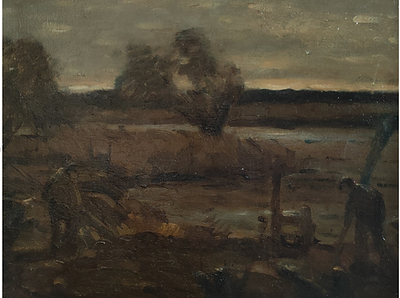The Light
That Remains....
Between 800 and 1200 Works of Light, Water, and Stillness
The collection of Thomas van Heck (1910–2006) comprises between 800 and 1200 works, of which 50% remain in family ownership. Together, they form a rare and coherent overview of an artist who captured more than seventy years of Dutch light, landscape, and daily life.
The oeuvre includes about 400 to 600 oil paintings and several hundred sketches, studies, and drawings in pencil, pastel, and oil. Van Heck’s subjects are deeply rooted in his surroundings — the rivers and harbours of Dordrecht, the Biesbosch wetlands, and the quiet courtyards and shipyards he observed with almost poetic precision.
His work is distinguished by subtle use of colour and a refined sensitivity to atmosphere. His paintings reveal not only what he saw, but also what he felt — the slow morning light, the mist above the water, and the calm of a Dutch afternoon.
Part of the collection is housed in museum collections, including the Dordrechts Museum and the Biesbosch MuseumEiland, while other works remain in private hands in the Netherlands and Belgium.
The Thomas van Heck Foundation is currently undertaking a comprehensive inventory and digitization of the oeuvre, ensuring its preservation and opening it — for the first time — to researchers, museums, and the public.



#1
The City
and Its Light...
At the heart of Van Heck’s work lies Dordrecht, the city where he lived, worked, and observed the meeting point between tradition and modernity. In his views of harbours, shipyards, construction sites, and bridges, he portrayed a world in quiet transformation. His brush recorded not the noise of progress, but its rhythm — the slow dance of light over steel, brick, and water.
These urban scenes, often painted in tones of grey, ochre, and soft blue, reflect his fascination with the dignity of work and the beauty of industry. The cranes, boats, and dockworkers that populate his canvases are never anonymous: they are part of a living landscape. In his cityscapes, the light itself becomes a citizen of Dordrecht, shaping the mood and movement of each day.



#2
Nature
and the River...
The second body of work captures Van Heck’s deep connection to the rivers and wetlands of the Biesbosch. These paintings reveal an artist who understood the Dutch landscape as both fragile and eternal — a place where land, water, and air constantly negotiate their balance.
His river scenes are marked by quiet horizons, soft reflections, and weathered skies. Morning mist dissolves into silver light; boats drift through still water; reeds tremble in the wind. Through subtle colour and rhythm, Van Heck expressed the serenity and solitude of the Dutch delta. These works are less about depiction and more about atmosphere — a record of how it feels to stand in silence beside a river that never stops moving.


#3
The Stillness
Between Moments...
The most intimate part of his oeuvre reveals Van Heck’s inner landscape — interiors, still lifes, and studies of light and quiet. These works, often small in scale, show the artist at his most reflective. Here, everyday objects — a window, a table, a single vase of flowers — are transformed by his patient gaze into meditations on time and transience.
In these paintings, Van Heck’s brush becomes a listener. He captures not motion but pause: the moment when the world holds its breath. The stillness is not emptiness but presence — the presence of attention, of care, of seeing without interruption.
Together, these three collections — the city, the river, and the stillness — form a single artistic journey. They show an artist who understood that the essence of Dutch life is not in grandeur but in continuity; not in spectacle but in light. Through them, Thomas van Heck preserved what endures: the poetry of ordinary days.

